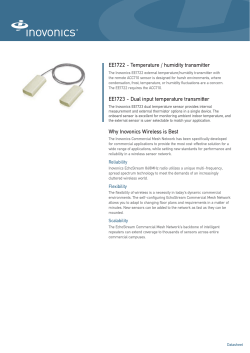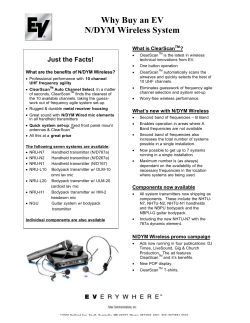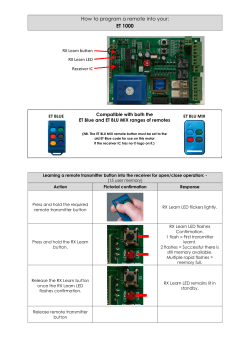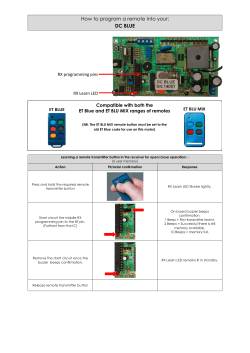
Worldwide Supplier of Gas Detection Solutions
Worldwide Supplier of Gas Detection Solutions GfG Instrumentation 1194 Oak Valley Drive Phone: 734-769-0573 Fax: 734-769-1888 E-Mail: info@gfg-inc.com Internet: www.gfg-inc.com Transmitter IR24 Models MWG 2491 / MWG 2492 Operation Manual Content Page For your Safety General Description Operational Hints Design Detection Principle Mounting Position of Transmitter IR24 Mounting Electrical Connections Putting into Operation Check of Electrical Zero point Check of Sensitivity Service Maintenance and Inspection Trouble Shooting Spare Part List Accessories Connection Diagram MWG 2492 Connection Diagram MWG 2491 Terminal Diagram IR24 Technical Data 1 1 2 2 3 3 3 4 4 5 6 7 8 8 8 8 9 9 10 10 For your Safety Like any piece of complex equipment, the IR24 will only do the designed job, if it is used and serviced in accordance with the manufacturer's instructions. This manual must be carefully read by all individuals who have or will have the responsibility of using and servicing this product. The warranties made by GfG with respect to the product are null and void, if the product is not used and serviced in accordance with the instructions in this manual. Please protect yourself and your employees by following them. The above does not alter statements regarding GfG warranties and conditions of sale and delivery. General Description A fixed gas monitoring system is a combination from a transmitter (MWG) and a control module (GMA). Remote sensor and controller are connected by cable. The transmitter converts the value of the gas concentration to an electrical signal and transmits it to the control module for evaluation. Fixed gas measurement and warning system 5 Vol% CO2 A 3 A 2 1 00 MEN U CHANN EL 8 0 A 1 o u t/ N 6 0 A3 A2 in /M A 4 0 F A U L T 1 U 2 0 % ON F AU L T TUE ST QU IT MEN U MEN U Auswerten Evaluation Messen Measurement Alarmieren Warning Fig. 1 The IR24 is an "intelligent" transmitter. Its comprehensive electronics allows easy operation and maintenance and also increases the operational safety and accuracy. The special features of the transmitter IR24 are: • • • • -1- State-of-the-art infra-red measurement technology (IR) for high reliability and long lifetime. Easy calibration at site. Service lid for adjustment of zero point and sensitivity. Thermostatic sensor for compensation of temperature effects. Operational Hints Before shipment, the transmitter IR24 passes a function and display test, being calibrated with suitable test gases. This does not, however, overrule the obligation to arrange for another function test after putting the transmitter in operation. Design The design of the transmitter IR24 is shown in fig. 2. Transmitter IR24 – Design Gehäuseoberteil Casing top (Deckel) Gehäuseunterteil Casing bottom Messbereich Detection range 5 Vol % CO2 Messgas Gas Befestigungsschraube Lock screw for für die Serviceklappe service lid Serviceklappe Service lid Cable gland Messkabeldurchführung PG PG-Verschraubung screwing Diffusionsfläche Diffusion inlet Fig. 2 The transmitter IR24 is protected by a solid metal casing. The diffusion inlet is at the bottom of this casing. Behind a service lid you find zero point and span potentiometers as well as test sockets for a volt meter. Inside the casing you find the main and calibration p.c.boards. The circuit on the main p.c.board converts the sensor signal into the output current 4 .. 20 mA resp. 0.2 .. 1 mA. The calibration p.c.board contains the operation elements. -2- Detection Principle The infra-red sensor uses the characteristics of gases to absorb light in certain spectrum ranges. The infra-red light emitted by a lamp passes the measurement distance through the gas sample. The gas absorbs the light, thus reducing the radiation energy. The amount of absorption of the infra-red radiation in a certain range of wavelengths depends on the concentration of the gas to be measured. Detectors measure the energy reduction of the infra-red radiation caused by absorption. Mounting Position of Transmitter IR24 It is essential to exactly know the ambient conditions, which have to be taken into consideration before deciding on the mounting position. To achieve representative measurement results, take care of • • the room ventilation and the gas density of carbon dioxide (CO2), which is greater than that of air. The gas, therefore, accumulates close to the floor. Install the transmitter IR24 at a place where the gases pass the sensor even in case of bad ventilation. If necessary, use a smoke cartridge to check. Furthermore, take the following into consideration as well: • • Rain water, hose water, dripping water, condensate and dust in the atmosphere. The transmitter IR24 is to a great extent protected against the entering of water and dust (IP 54). Special accessories are available to provide additional protection for very difficult conditions. Please contact GfG for detailed information. ! Warranty may be voided, if the sensor is exposed to ambient conditions which were unknown to GfG during planning, production or delivery. When deciding on the position for the transmitter, make sure that it is always accessible for service and maintenance. It is recommended to mount the transmitter with the sensor showing to the floor. Different installation, however, does not affect the measurement accuracy. Mounting For connecting the transmitter IR24 refer to the terminal diagram (page 12) and to the connection diagram IR24 (page 11). For mounting the transmitter remove the four special screws (fig. 2, pos. 9) and take the casing top off. Fix the casing by means of two borings. -3- Electrical Connections Procurement of cable and electrical connections must be done by a specialist only, obeying the applicable regulations. Depending on the model or the operation of the transmitter IR24, a shielded 3-core or multi-core cable has to be used (18 gauge shielded). The cross section of the cable depends on the cable length. For short distances (max. 200 m) it may be sufficient to 3 strand 18 gauge shielded cable. The shield is to be connected to the PG screwing. In case the transmitter is operated on a mains unit or on another manufacturer's system, the operation voltage must not exceed 24 V DC. After installation fix the casing top with the four special screws. Installation and opening the casing must always be done in clean air. Terminals of Transmitter IR24 4 5 6 brown green white 24V Ground4 .. 20 mA 0,2 .. 1 mA GMA Fig. 3 Putting into Operation Once the transmitter IR24 is installed, a skilled person can put it in operation. The IR 24 has been calibrated and tested before shipment. The factory-done calibration is effected after the transmitters have run in for several days, which is the optimum for the basic adjustment. When the transmitter is turned on, the infra-red sensor needs a certain time to warm up. Allow about 15 to 30 minutes before you check the calibration. -4- Check of Electrical Zero point The transmitter IR24 is calibrated and tested before shipment. Certain deviations, however, are possible due to transport, mounting and ambient conditions. Note: The electrical zero point can only be set, if the transmitter is exposed to 100 Vol.-% nitrogen or CO2-free synthetic air. The transmitter needs a warm-up time of about 30 minutes. Earlier zero point adjustment affects the manufacturer’s sensor setting. Once the warm-up is finished, you can connect a volt meter to the test sockets (UM) behind the service lid of the IR24 (fig. 4) and those of your GMA controller to check the voltage (please read the operation manual for your GMA controller carefully). Transmitter IR24 - Printed Circuit Board Sicherung Fuse SI1 SI1 Service switch Serviceschalter Terminal bar Klemmleiste SERVICE SERVICE Potentiometer BETRIEB OPERATION Potentiometer" ZEROPOINT NULLPUNKT" Test socket UM Potentiometer Potentiometer CALIBRATION "KALIBRIEREN" Prüfbuchse UM for volt meter für Voltmeter PGVerschraubung screwing PG IR - Sensor Fig. 4 During zero point adjustment the service jumper should be turned to position "SERVICE". -5- Adhere to the following procedure to check the electrical zero point: Open service lid at IR24. Use calibration adapter to supply zero gas (100 Vol.-% N2 or CO2 -free synthetic air). The flow rate should be approx. 0.5 l/min. Service switch in position „SERVICE“ Connect volt meter to UM (see fig. 4) UM = 0.2 Volt ? yes no Use potentiometer „NULLPUNKT“ (zero point) to set voltage to 0.2 V. Service switch in position „OPERATION“. Close IR24 top. After 30 minutes check UN at GMA controller. UN should be 0 V. Deviations can be corrected at the GMA controller. Refer to the operation manual of your GMA controller. Check of Sensitivity Fix a test gas adapter on the diffusion inlet for checking the sensitivity and select a suitable test gas. Then check which gas has been used for initial calibration of the transmitter. You can see this information from the test report and from the type label at the transmitter. The test gas concentration should be at least 20 % above the second alarm threshold. Please refer to the test report of the transmitter for the basic adjustment of alarm thresholds and full scale. Note: The sensitivity can only be set by means of a suitable test gas. The transmitter needs a warm-up time of about 30 minutes. Earlier sensitivity adjustment affects the manufacturer’s sensor setting. During the sensitivity check the service jumper should be turned to pos. "SERVICE": -6- Adhere to the following procedure for checking the sensitivity: Open service lidentfernen at IR24. und 30 min Einlaufzeit abwarten. Deckel am IR24 Kalibrieradapter am IR24 befestigen. Fix calibration adapter at IR24. Servicejumper Service switch in in Position position "SERVICE" „SERVICE“. Supply drucklos test gas without pressure, at a von flowetwa rate 0,5 of approx. 0.5IR24 Prüfgas mit einem Durchfluß l/min dem l/min, to IR24. Test a CO2/airoder or CO 2/nitrogen mixture with zuführen. Prüfgas ist gas ein is CO2-LuftCO2-Stickstoff-Gemisch a CO equivalent fullMeßbereichendwert scale or at least 20 % above 2 concentration mit einer CO2 Konzentration die to dem entspricht the 2. alarm threshold. oder mindestens 20 % oberhalb der 2 Alarmschwelle liegt. Die Anzeige am 1Gasmesscomputer innerhalb von must etwa 1 Within approx. minute the displaymuß at thesich GMA controller min entsprechend dem Wert der Should Prüfgaskonzentration show the test gas concentration. you operate theeingestellt MWG haben. deryou MWG GMA betrieben, können withoutWird GMA, can ohne see the voltage valuesso from the die Spannungswerte der Kalibrierkurve entnommen und calibration curve and measure at IR24 output “UM”. am IR24-Ausgang "UM" gemessen werden. Is the measured value equivalent to Wert the value in the calibration Gemessener Wert stimmt mit dem der Kalibrierkurve curve? überein? ja neinNo Yes no yes Adjust calibration pointGasmesscomputer at IR24 or at the den An dem IR24 bzw. dem Kalibrierpunkt nachjustieren. bitte controller. Please refer to theBeachten operationSie manual die Betriebsanleitung des Gasmesscomputers. of your GMA. Servicejumper Service switch in inPosition position "MESSBETRIEB" „OPERATION“. Deckel am IR24 Close service lidbefestigen. at IR24. Prüfgas undtest Kalibrieradapter entfernen. Disconnect gas and calibration adapter. Service This function check means: • • • • • • Check with alarm gas concentration Check of zero point and sensitivity (calibration) Check of response time Check of gas sampling and gas processing system (if any) Check of alarm signal activation Check of failure alarm The check must be done by an expert, who has to report the result in written form. Generally the calibration intervals should not exceed 16 weeks. The function check is to be done before putting the system in operation, and it has to be done at least once a year. -7- Maintenance and Inspection Maintenance and inspection mean measures which ensures the planned status of the gas monitoring system. Although the transmitter IR24 does not require a special maintenance, you should take care of some points. Depending on the ambient conditions, gas monitoring systems may show a different behavior. It is important, therefore, to do a visual check every day, particularly during the first few days after putting in operation. • • • Check of gas processing system and filters (if any). Check of gas supply for soiling or obstacles (for correct measurement the gas supply to the sensor must not be blocked). Sensors are subject to ageing and exhausting. Depending on their type and on their exposure to gas they are more or less used up, so a sensitivity check can only be done with a suitable test gas after certain periods. The sensitivity calibration is an expert calibration and is usually done by GfG's service or by authorized persons. Trouble Shooting Failure Zero point cannot be adjusted Full scale cannot be adjusted Output current has fallen to 0 mA Reason Faulty sensor Faulty sensor Faulty fuse Cable cut Solution Replace sensor Replace sensor Replace fuse Re-fix connection Spare Part List Part No. 249x301 249x302 2491401 932026 Casing complete Casing top Spare sensor IR Fuse SI1 Accessories Part No. 2400209 Screw-in calibration adapter Spare parts and accessories may be stored at an ambient temperature of -40°C to 80°C. Replacing of parts or using the accessories may affect the operation as follows: Spare Part, Accessory Casing top Spare sensor Screw-in calibration adapter Effect of Ambient Temperature None Zero point and sensitivity adjustment None, if flow rate is 0.5 l/min -8- Connection Diagram Transmitter IR24 Model MWG 2492 at GMA Controller brown green white 4 5 6 GMA300 GMA101 GMA41 GMA81 (A) 24 V 5 5 28 1 GND 1 1 29 2 4 – 20mA 2 2 30 3 Connection Diagram Transmitter IR24 Model MWG 2491 at GMA Controller brown green white 4 5 6 GMA300 GMA011 GMA100 GMA100 GMA101 GMA41 GMA81 (A) -9- 24 V 5 5 5 3 5 28 1 GND 1 1 1 0 1 29 2 0.2 – 1 mA 2 2 with motherboard since model 97 (blue) 2 with motherboard until model 96 (no color) 2 2 30 3 Terminal Diagram IR24 4 U= 18.0 VV-–24,0 26.0VV 18,0 5 MWG 2492 MWG 2491 R1 I = 4 - 20 mA 6 Max. load 150 Ohm Use shielded cable for distances of more than 5 m Technical Data Transmitter IR24 Transmitter Type: MWG 2491 and MWG 2492 Gas: Carbon dioxide (CO2) Detection Ranges: 0 .. 1 Vol.-% 0 .. 5 Vol.-% Gas supply: Diffusion Detection Principle: Infra-red (IR) Supply Voltage: 18...26 V DC max. Current consumption: 100 mA Response Time T90: 25 s Expected Sensor Life: 5 years Operational Conditions Operational temperature: -20 .. 40 °C Humidity Range: 0 .. 99 % r.h., non-condensing Atm. Pressure Range: 800 .. 1200 mbar Worldwide Supplier of Gas Detection Solutions GfG Instrumentation 1194 Oak Valley Drive Phone: 734-769-0573 Fax: 734-769-1888 E-Mail: info@gfg-inc.com Internet: www.gfg-inc.com Edition June 1, 2001 GfG reserves the right of modification -10-
© Copyright 2025









